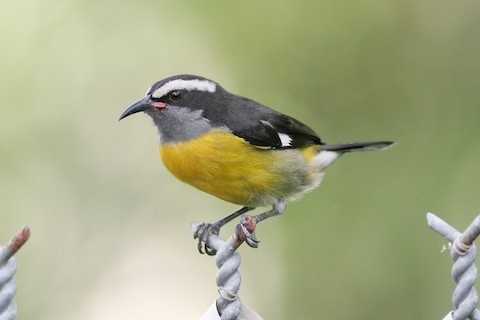Birdfinding.info ⇒ The Puerto Rican endemic form of Bananaquit is common to abundant in woodland edges, gardens, and scrub, and probably the most numerous resident songbird throughout its range.
“Puerto Rican Bananaquit”
Coereba flaveola portoricensis
Endemic to Puerto Rico and the Virgin Islands, where it occurs in all habitats at all elevations.
The boundaries between Bananaquit forms are confusing and unsettled. Three recognized subspecies inhabit the Puerto Rican archipelago: portoricensis on Puerto Rico; sanctithomae on Culebra, Vieques, and the Virgin Islands, except St. Croix; and nelsoni on St. Croix. Among this trio, only portoricensis is usually identified as “Puerto Rican”, which has been shown to be genetically divergent from both “Greater Antillean” and “Lesser Antillean” forms. The Virgin Islands subspecies are usually identified with the “Lesser Antillean” form, but sanctithomae and portoricensis appear to be near-identical both visually and vocally, and nelsoni is also very similar. The populations of the Puerto Rican archipelago appear to comprise a single form.
Identification
Like other Bananaquits, it is readily recognized by its curved, sharp-tipped bill, broad white eyebrows, blackish mask and upperparts, and yellow breast.
Other distinctive features include an ashy-gray throat, yellow rump, yellow shoulders, and a large white spot at the base of the primaries. The gape at the base of its bill is partly pale-pink.

“Puerto Rican Bananaquit,” C. f. portoricensis. (Fajardo, Puerto Rico; March 21, 2017.) © Frédéric Pelsy
The “Puerto Rican Bananaquit” is visually indistinguishable from the “Greater Antillean” subspecies which inhabits neighboring Hispaniola. The known differences between them are vocal and genetic. It differs from the nearest “Lesser Antillean” subspecies, of the Leeward Islands, most obviously in their wing patterns—because “Lesser Antillean” has all-dark wings.
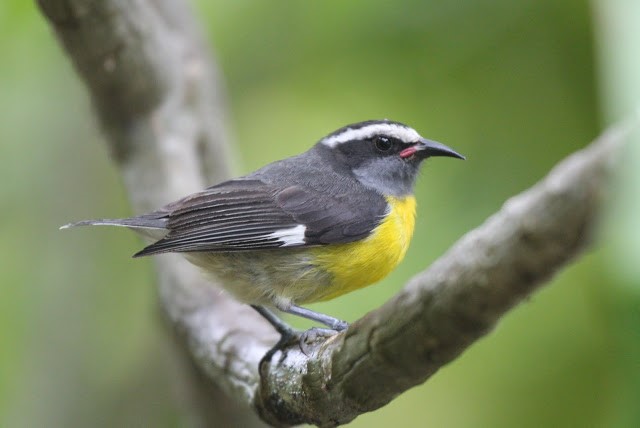
“Puerto Rican Bananaquit”, C. f. sanctithomae. (St. John, U.S. Virgin Islands; July 19, 2012.) © Jason Crotty
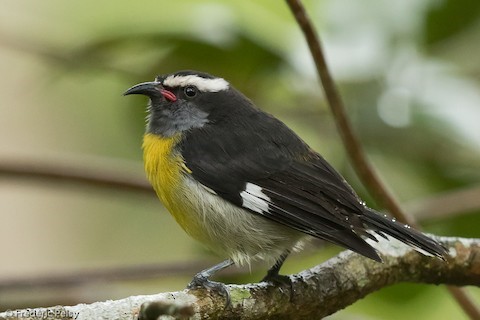
“Puerto Rican Bananaquit”, C. f. portoricensis. (Utuado, Puerto Rico; March 21, 2017.) © Frédéric Pelsy
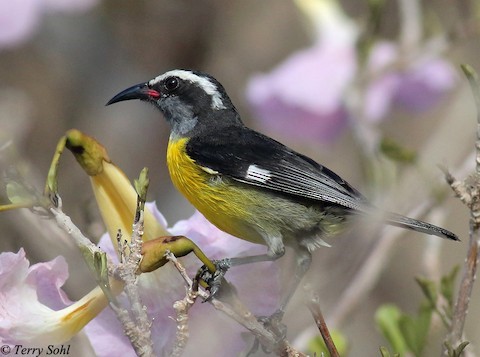
“Puerto Rican Bananaquit”, C. f. sanctithomae. (St. John, U.S. Virgin Islands; June 9, 2015.) © Terry Sohl
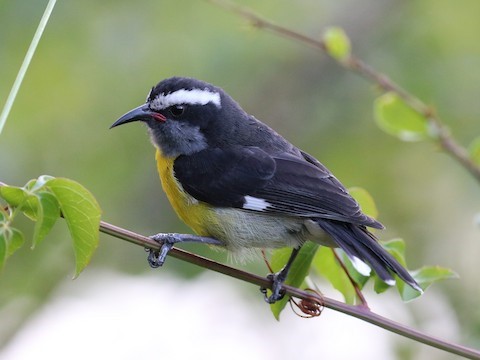
“Puerto Rican Bananaquit”, C. f. sanctithomae. (Frank Pond, St. John, U.S. Virgin Islands; March 3, 2020.) © Mjack13
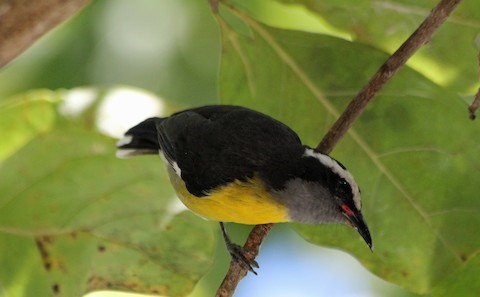
“Puerto Rican Bananaquit”, C. f. sanctithomae. (St. John, U.S. Virgin Islands; March 14, 2012.) © Graham Williams
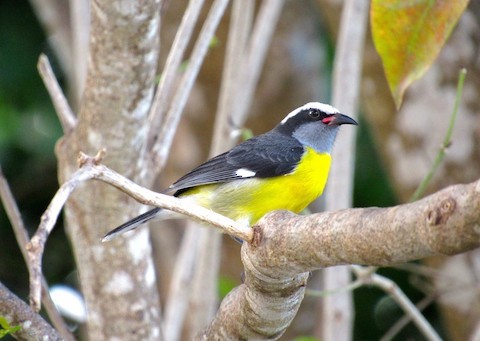
“Puerto Rican Bananaquit”, C. f. sanctithomae. (St. John, U.S. Virgin Islands; February 1, 2017.) © Kisa Weeman

“Puerto Rican Bananaquit”, C. f. sanctithomae. (St. John, U.S. Virgin Islands; January 20, 2015.) © Pat Mulligan
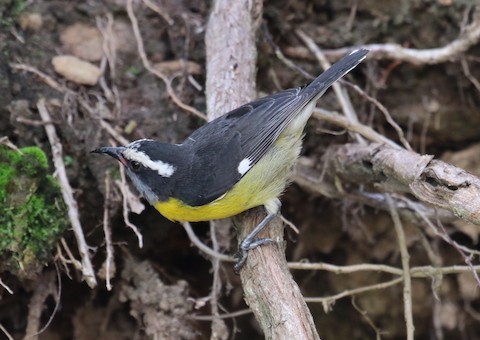
“Puerto Rican Bananaquit”, C. f. sanctithomae. (St. John, U.S. Virgin Islands; November 4, 2020.) © James Ogilvie
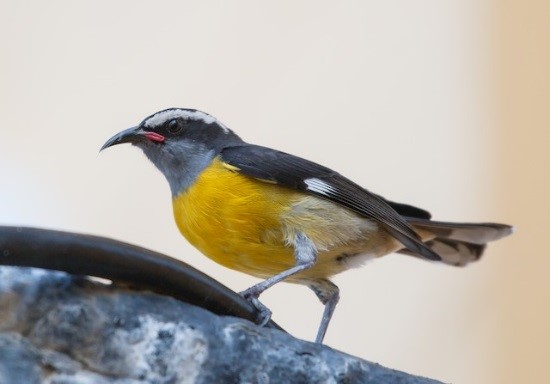
“Puerto Rican Bananaquit”, C. f. portoricensis. (Parque Luis Muñoz Rivera, San Juan, Puerto Rico; February 13, 2016.) © Simon Best
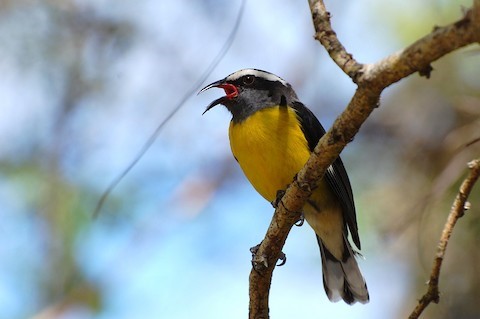
“Puerto Rican Bananaquit”, C. f. sanctithomae, singing. (Esperanza, Vieques, Puerto Rico; December 17, 2014.) © Irina Shulgina
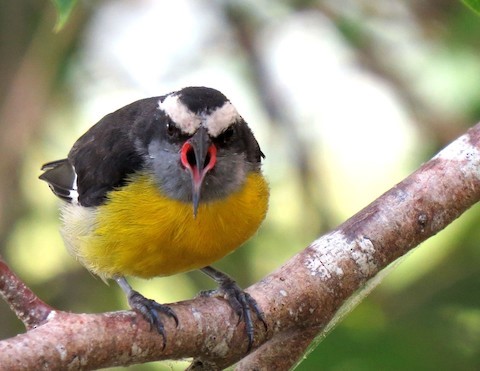
“Puerto Rican Bananaquit”, C. f. sanctithomae. (Cayo de Tierra, Vieques, Puerto Rico; October 27, 2013.) © John Martin
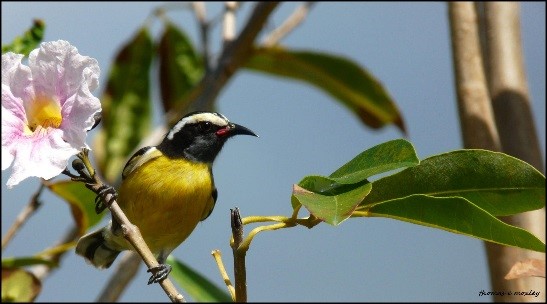
“Puerto Rican Bananaquit”, C. f. newtoni. (St. Croix, U.S. Virgin Islands; April 10, 2009.) © Tom Moxley
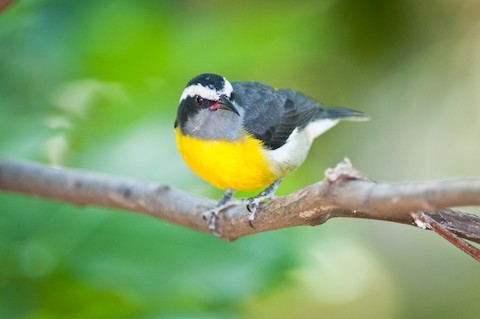
“Puerto Rican Bananaquit”, C. f. sanctithomae. (Frank Pond, St. John, U.S. Virgin Islands; January 16, 2011.) © Stephen Davies

“Puerto Rican Bananaquit”, C. f. portoricensis. (Utuado, Puerto Rico; March 21, 2017.) © Alex Lamoreaux
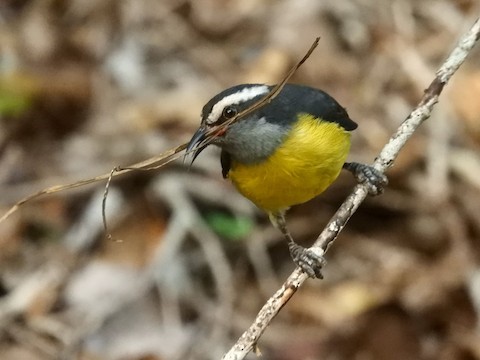
“Puerto Rican Bananaquit”, C. f. portoricensis, carrying nest material. (Guánica State Forest, Puerto Rico; October 10, 2019.) © Scott Keyes

“Puerto Rican Bananaquit”, C. f. portoricensis. (Rancho Vegas, Cayey, Puerto Rico; January 19, 2017.) © José Santiago

“Puerto Rican Bananaquit”, C. f. newtoni. (Point Udall, St. Croix, U.S. Virgin Islands; February 17, 2019.) © Gabriel Rodriguez
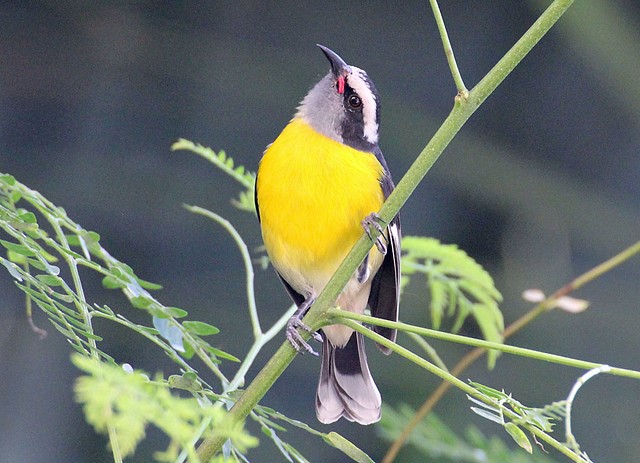
“Puerto Rican Bananaquit”, C. f. sanctithomae. (St. John, U.S. Virgin Islands; January 20, 2015.) © Pat Mulligan
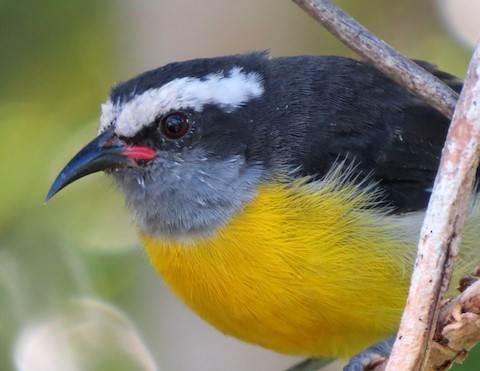
“Puerto Rican Bananaquit”, C. f. sanctithomae. (Cayo de Tierra, Vieques, Puerto Rico; October 27, 2013.) © John Martin
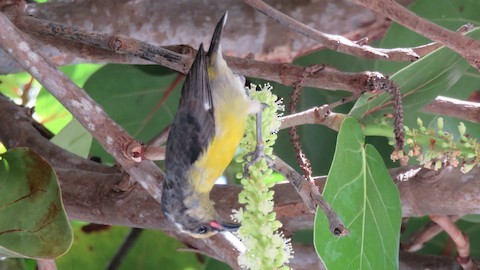
“Puerto Rican Bananaquit”, C. f. sanctithomae, immature. (Anegada, British Virgin Islands; May 21, 2019.) © Elsie Schwing
Immatures are similar to adults but have mostly brownish upperparts and dingy-yellow underparts and eyebrows.
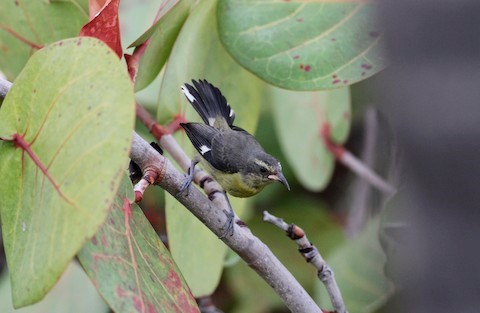
“Puerto Rican Bananaquit,” C. f. portoricensis, immature, showing upperparts pattern including white wingspot. (La Parguera, Puerto Rico; April 23, 2014.) © Jay McGowan
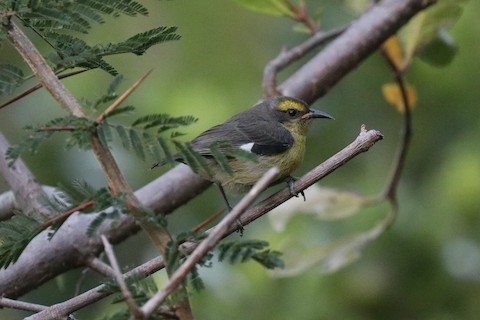
“Puerto Rican Bananaquit”, C. f. sanctithomae, immature. (Frank Pond, St. John, U.S. Virgin Islands; February 27, 2020.) © Mjack13
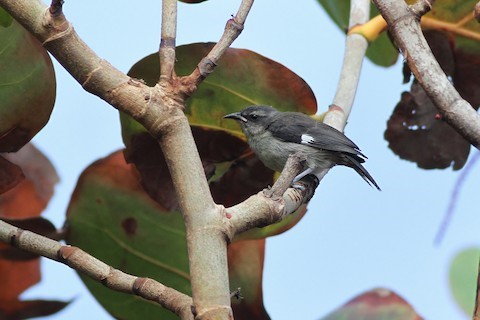
“Puerto Rican Bananaquit”, C. f. portoricensis, immature with all-gray underparts. (Viejo San Juan, Puerto Rico; March 20, 2017.) © Alex Lamoreaux

“Puerto Rican Bananaquit”, C. f. portoricensis, immature. (Cataño, Puerto Rico; April 22, 2021.) © Victor Feliciano
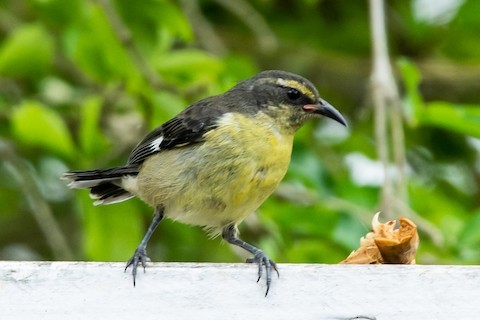
“Puerto Rican Bananaquit”, C. f. portoricensis, immature. (Aibonito, Puerto Rico; May 8, 2021.) © Hector Rivera

“Puerto Rican Bananaquit”, C. f. portoricensis, immature. (Rancho Vegas, Cayey, Puerto Rico; June 24, 2018.) © José Santiago

“Puerto Rican Bananaquit”, C. f. sanctithomae, immature. (St. Thomas, U.S. Virgin Islands; December 6, 2016.) © Phil McNeil

“Puerto Rican Bananaquit”, C. f. sanctithomae, immature. (St. Thomas, U.S. Virgin Islands; December 6, 2016.) © Phil McNeil
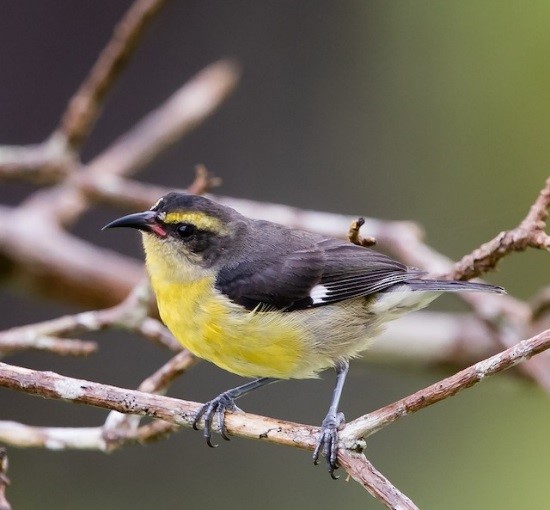
“Puerto Rican Bananaquit”, C. f. portoricensis, immature. (Rancho Vegas, Cayey, Puerto Rico; June 24, 2018.) © José Santiago
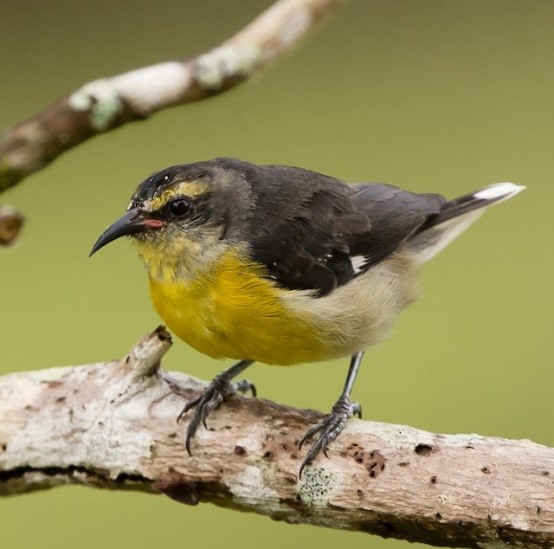
“Puerto Rican Bananaquit”, C. f. portoricensis, immature. (Rancho Vegas, Cayey, Puerto Rico; June 24, 2018.) © José Santiago
Cf. “Greater Antillean Bananaquit”. The “Puerto Rican Bananaquit” (portoricensis, plus the two Virgin Islands subspecies, sanctithomae and newtoni) is visually indistinguishable from the nearest subspecies of “Greater Antillean” (bananivora of Hispaniola). The only consistent differences between “Greater Antillean” and “Puerto Rican” are their voices, especially their songs. “Greater Antillean’s” is usually an evenly-spaced series of fairly clear, high-pitched notes, whereas “Lesser Antillean’s” consists of a wheezy trill followed by a burst of sharp chip notes or a sharp trill.
Cf. “Lesser Antillean Bananaquit”. The “Puerto Rican Bananaquit” (portoricensis, plus the two Virgin Islands subspecies, sanctithomae and newtoni) differs from the nearest “Lesser Antillean” subspecies (bartholemica) of the Leeward Islands most obviously in the wing pattern: “Puerto Rican” has a white spot at the base of the primaries, whereas “Lesser Antillean” has either entirely blackish wings or very thin pale wingbars.
Notes
Polytypic form consisting of three recognized subspecies, collectively comprising one of approximately ten potentially distinct forms of Bananaquit. The “Puerto Rican Bananaquit” includes the endemic subspecies of Puerto Rico (portoricensis) and the Virgin Islands (sanctithomae and newtoni). The taxonomic status and scope of this form are unsettled. It is visually indistinguishable from the “Greater Antillean Bananaquit” (flaveola and especially bananivora) but vocally indistinguishable from and genetically related to the “Lesser Antillean Bananaquit” (bartholemica et al.). Most references that distinguish “Puerto Rican” from “Lesser Antillean” classify the Virgin Islands subspecies under the latter, but they have stronger affinities (visual, vocal, and geographical) with “Puerto Rican”.
Frontiers of Taxonomy: Bunches of Bananaquits. The forty-or-so subspecies of Bananaquit vary significantly in plumage and voice, and it seems clear that what has traditionally been recognized as a single species consists of several distinguishable forms, which likely represent at least two species, and perhaps as many as ten, but it is a complex puzzle.
Mitochondrial DNA analysis (Bellemain et al. 2008) indicates that the oldest splits are among three lineages: “Bahama” (bahamensis, plus the “Cozumel” subspecies, caboti); “Greater Antillean” (Jamaican flaveola, Hispaniolan bananivora, “Cayman” sharpei, and possibly also the similar “Providencia” form, which includes tricolor and oblita); and the rest (which can be subdivided into “Lesser Antillean” and “Continental” groups).
The same analysis indicates that oldest division among the “Lesser Antillean” lineages is “Puerto Rican” (portoricensis—and possibly also sanctithomae and newtoni of the Virgin Islands), which has the appearance of “Greater Antillean” with a “Lesser Antillean” voice. The analysis also found a significant division between the “Dimorphic” form (aterrima of Grenada and atrata of St. Vincent) and the remaining “Lesser Antillean” subspecies (bartholemica plus martinicana, barbadensis, uropygialis, and bonairensis). Finally, not sampled in the analysis, but apparently related to “Dimorphic”, is the Venezuelan “Blackish” form (laurae plus melanornis, lowii, and possibly also frailensis).
References
Bellemain, E., E. Bermingham, and R.E. Ricklefs. 2008. The dynamic evolutionary history of the bananaquit (Coereba flaveola) in the Caribbean revealed by a multigene analysis. Evolutionary Biology 8:240.
Bellemain, E., O.E. Gaggiotti, A. Fahey, E. Bermingham, and R.E. Ricklefs. 2012. Demographic history and genetic diversity in West Indian Coereba flaveola populations. Genetica 140:137-148.
BirdLife International. 2016. Coereba flaveola. The IUCN Red List of Threatened Species 2016: e.T22722080A94747415. https://dx.doi.org/10.2305/IUCN.UK.2016-3.RLTS.T22722080A94747415.en. (Accessed May 21, 2021.)
eBird. 2021. eBird: An online database of bird distribution and abundance. Cornell Lab of Ornithology, Ithaca, N.Y. http://www.ebird.org. (Accessed May 21, 2021.)
Howell, S.N.G., and S. Webb. 1995. A Guide to the Birds of Mexico and Northern Central America. Oxford University Press, Oxford.
Kirwan, G.M., A. Levesque, M. Oberle, and C.J. Sharpe. 2019. Birds of the West Indies. Lynx Edicions, Barcelona.
Raffaele, H., J. Wiley, O. Garrido, A. Keith, and J. Raffaele. 1998. A Guide to the Birds of the West Indies. Princeton University Press, Princeton, N.J.
Seutin, G., N.K. Klein, R.E. Ricklefs, and E. Bermingham. 1994. Historical Biogeography of the Bananaquit (Coereba flaveola) in the Caribbean Region: A Mitochondrial DNA Assessment. Evolution 48:1041-1061.
Xeno-Canto. 2021. Bananaquit – Coereba flaveola. https://www.xeno-canto.org/species/Coereba-flaveola. (Accessed May 21, 2021.)
